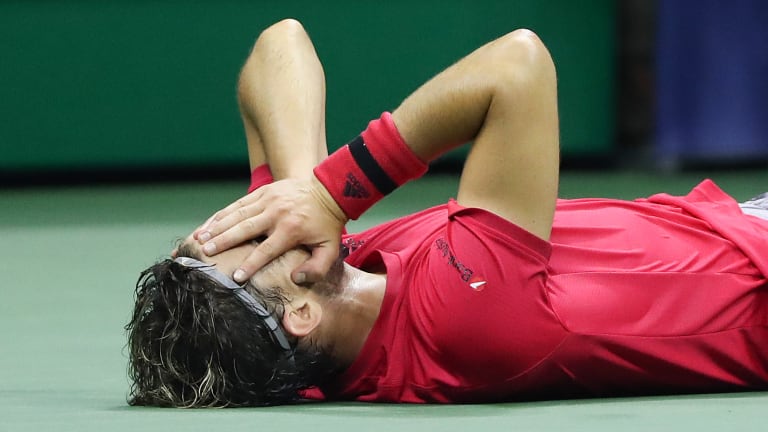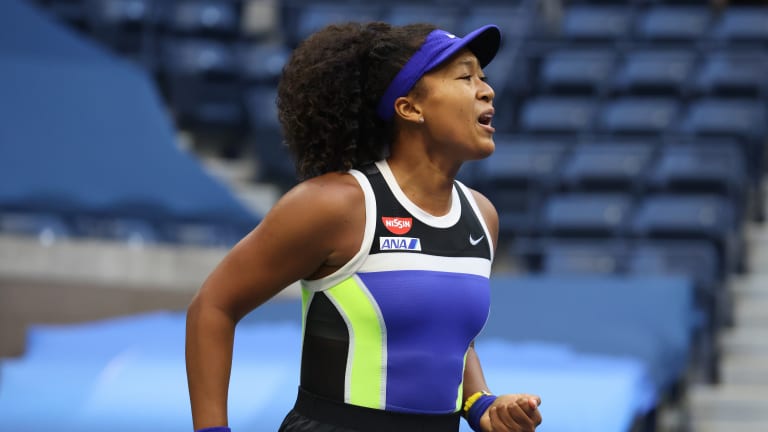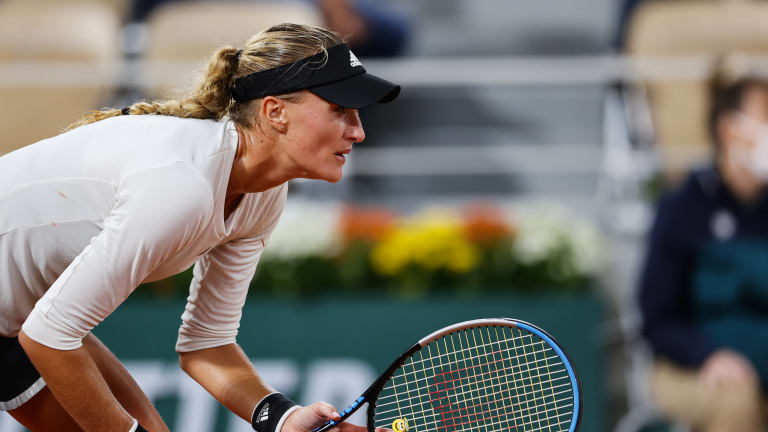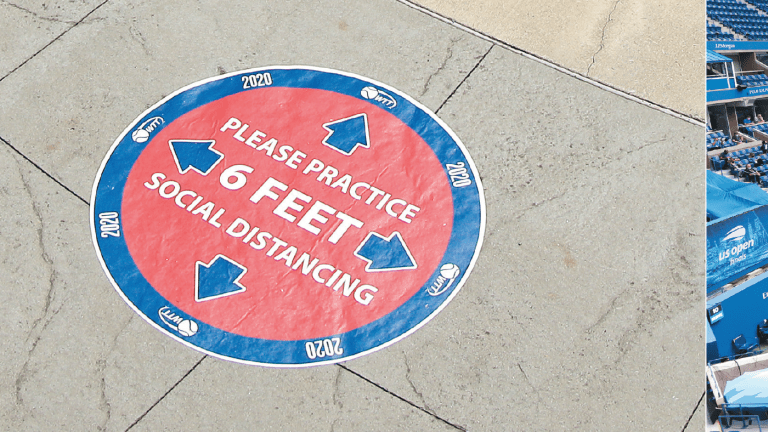Tennis' lessons learned: The return of the pro game
By Peter Bodo Nov 13, 2020Madrid Open Betting Preview: Ekaterina Alexandrova vs. Daria Kasatkina
By Zachary Cohen Apr 27, 2025Tommy Paul twice saves two set points to see off Joao Fonseca in Madrid night clash
By TENNIS.com Apr 26, 2025Simple man Matteo Arnaldi 'privileged' by EA7 partnership, eyes future singlet fit from Armani
By Matt Fitzgerald Apr 26, 2025Matteo Berrettini battles to milestone 200th win of career with victory over Giron in Madrid
By John Berkok Apr 26, 2025Novak Djokovic loses third consecutive match, to Matteo Arnaldi in Madrid
By Ed McGrogan Apr 26, 2025Racquet Review: Head Radical Pro 2025
By Jon Levey Apr 26, 2025Taylor Townsend confirms she will be ‘front and center' at Roland Garros following concussion in Miami
By Liya Davidov Apr 26, 2025Looking for love? Madison Keys says there are plenty of fish in the sea
By Baseline Staff Apr 26, 2025Novak Djokovic vs. Matteo Arnaldi: Where to Watch, Madrid Preview, Betting Odds
By TENNIS.com Apr 26, 2025Tennis' lessons learned: The return of the pro game
As the US Open showed, there’s still so much work left to do,
Published Nov 13, 2020
Advertising
The USTA did a magnificent job creating a bio-secure environment in which the “double in the bubble,” consisting of the Western & Southern Open and the US Open, was played in Flushing Meadows. Though fans were not allowed on site, and the events took place under strict health protocols due to the COVID-19 pandemic, the impaired stretch was an enormous success.
It was also an enormously teachable moment, one of many we can mine from the long lockdown and eventual return of pro tennis. So what did tennis learn from its confrontation with the coronavirus over the course of six months? These six takeaways will be crucial to the sport’s immediate and longterm future.
The international nature of tennis has always been one of the game’s most powerful attractants. The pandemic quickly turned it into one of the sport’s greatest vulnerabilities. Without relatively free, easy-access travel across international borders, tennis as we know it will not survive.
When COVID-19 restrictions, onerous testing and quarantine regimens were established, it made the prospect of returning to tour tennis appealing but potentially untenable, even with a bubble approach. The immediate and greatest source of confusion for the pros when the USTA announced its bold plan was travel-related.
Nobody really knew who, among those not already in the U.S., would be allowed to enter the country. It was unclear what health protocols traveling pros would face vis a vis quarantine and testing upon arrival, and whether players would be allowed back into their own domiciles, or some other destination, after their stay was complete.

Tennis' lessons learned: The return of the pro game
© Getty Images
Advertising
Those uncertainties, layered atop the basic fear of infection, made many players reluctant to commit to the US Open. Novak Djokovic, who said the USTA’s initial set of health protocols made it “impossible” for him to compete at the US Open, softened his stance in mid-July, telling Spanish newspaper Marca that he would play—if the USTA would guarantee that he would not have to quarantine upon his return to Europe. That emerged as a critical issue due to the short two-week time span between the end of the US Open and the start of the rescheduled Roland Garros.
The USTA was able to give Djokovic assurances on that front, initiating what is likely to be an ongoing engagement with health and diplomatic officials both in the U.S. and other nations. USTA CEO Mike Dowse said that the key to resolving such travel issues was “constant contact” and collaboration with entities far removed from the tennis world.
“You think about all the government entities,” said Dowse. “It started at the federal level with us. We even had international diplomacy as we had to work to get players in and out of the country.”
Tennis officials will need to build an expanded and perhaps formalized communications infrastructure if they wish to give players a greater sense of security about competing in tournaments away from home.
We all know what fans bring to sports: energy, color, inspiration, excitement—and last but by no means least, boatloads of cash that translates into operating income. When the pandemic hit, the idea of staging events with live spectators was unthinkable. Rafael Nadal himself said he could not conceive of competing in a US Open without fans present, and ultimately decided against playing it (with travel and virus concerns the primary reason).

Tennis' lessons learned: The return of the pro game
© Getty Images
Advertising
But this US Open was full of close, compelling matches, and it produced two memorable finals. Sure, we missed cutaways to cheering crowds, and scenic shots of plazas and walkways jammed with spectators. And while all the pros said they missed the fans, they all also performed with all the artistry, determination, grit and energy that makes tennis such an appealing sport.
Did we miss being in attendance or seeing fans on television? You bet. But the US Open was still a great athletic spectacle.
The US Open tournament could have been significantly damaged as a result of contact tracing, but a potential disaster was averted due to, of all things, a lack of communication between various governmental health agencies.
Benoit Paire was the first—and, ultimately, only—player to test positive for the coronavirus in Flushing Meadows. He was removed from the tournament before play started. Contact tracers also identified seven players, including tour veterans Richard Gasquet, Kirsten Flipkens, Kristina Mladenovic and Adrian Mannarino, all of whom were deemed to have been inclose enough contact with Paire to be placed into “enhanced protocols.” That put them, as Mladenovic said, inside “a bubble within the bubble.”
These players were tested more frequently, and essentially ordered to stay in their rooms unless they were practicing or playing.
Six days into the tournament, the Nassau County Board of Health (with jurisdiction because the official player hotels were in Nassau County) issued a notice of quarantine dictating that the seven players remain at their hotels, essentially forbidding them to travel to and play at the US Open. The county’s decision overruled the New York City officials who had helped craft the tournament’s enhanced protocols and allowed the players to compete if they observed them.

Tennis' lessons learned: The return of the pro game
© AFP via Getty Images
Advertising
Fortunately for the US Open, the affected players were out of the tournament by then, with the exception of Mladenovic, who alongside Timea Babos comprised the top-seeded doubles team. They were removed from the draw because Mladenovic was one of the restricted players.
Also fortunate: the time spent under enhanced protocols counted toward the county quarantine, reducing the travel ban for most of the affected players to eight days.
“Having to stay another eight days, locked in your hotel room, is not what you want when you are eliminated from a tournament,” said Ysaline Bonaventure, whose hopes of qualifying for the following week’s Italian Open in Rome were dashed due to the quarantine. “It’s the same for everyone who has been in contact with Benoit.
“Apart from accepting and patiently dealing with your pain, there is not much you can do.”
The lesson: tennis officials and players were blindsided by the county’s move—and while there’s no question that contact tracing is an absolute necessity, tennis and health officials need to be better prepared for dealing with the results.
Tennis began making its way back this summer with baby steps, but the one thing pioneering exhibition tournaments in Germany, the Czech Republic, Italy and California all had in common was regional flavor. If the international character of tennis is a disadvantage
in one sense, it is an advantage in another: there are clusters of excellent players in almost any part of the developed world, making regional play not only viable but, as we saw during the pandemic, the only form of the tournament game that can be presented.
The ATP and WTA have regional swings that give the calendar a sense of geographic flow. But unlike golf, there are no regional tours that allow players in a specific part of the world to compete mostly in their region. Tennis players chase rankings points helter-skelter, all over the globe.

Tennis' lessons learned: The return of the pro game
Advertising
A number of the game’s thinkers and power brokers, including former USTA CEO of professional tennis Arlen Kantarian, have advocated for a more regional approach to the game. The pandemic showed that it could be made to work—and perhaps should be made to work.
“Maybe it’s time to re-think some of the stuff we’ve talked about for a long time,” Tennys Sandgren told me in a recently. “Regional tours, team play, things like that all started to look pretty good when nobody was getting paid. It makes you think of alternatives.”
Both the ATP and WTA have contractual obligations with the events that comprise their tours, and few of the rights-holders want to see their options restricted. But if the game rebounds and continues to grow, regional tours also may emerge as a way to create more events—and more job opportunities.
World TeamTennis played an entire season in a span of 19 days in July at The Greenbrier in West Virginia, complete with safeguards against the spread of the coronavirus. Granted, WTT matches are quick, slam-bang affairs featuring streamlined scoring, but the 2019 Davis Cup and the 2020 season-kickoff ATP Cup were also contested in relatively brief time frames.
The popularity and hunger for more team events—both from the players and fans—was one of the hottest topics of tennis conversation before the pandemic struck. The tipping point was the enormous success of the Laver Cup, a three-day international event and Roger Federer’s brainchild.
As the mercurial and unfiltered Australian star Nick Kyrgios said following the 2019 edition, referring to the empty seats that are so visible during the early stages of week-long tennis events, “You look at the Laver Cup, you had 17,000 people cheering every night. For entertainment purposes, I don’t think too many people are going to tune in to watch a 250 event in Antwerp.”
The shortcomings of the global game’s unwieldy tournament format, which has remained unchanged since the tours were born some 50 years ago, were driven home by the pandemic. Maybe it’s time to re-think how we present tennis.

Tennis' lessons learned: The return of the pro game
Advertising
The idea of a “clean passport” sprang from anti-doping efforts. It is essentially the opposite of the way doping has been addressed thus far, with testers trying to catch cheats. In the clean-passport plan, players submit to regular periodic monitoring of their essential biochemical profiles. Thus, any spike or noteworthy change in the data is registered and monitored. A player with a clean passport could more easily demonstrate that he or she is free of infection.
“As long as there is no vaccine or reliable therapy [for COVID-19] there will be travel restrictions, so how do we make it possible for players to take part in tournaments?” asks WTA president Micky Lawler. “The clean passport is something that may be in the future, for everyone.”
Kelly Wolf, a vice president at tennis management and promotion firm Octagon, believes the game may be transformed in the long term due to the pandemic. As she says, it’s worth considering new ideas, and ones that were previously dismissed.
“People are trying to hold onto the past,” she said. “Maybe they think they can save it, but you can’t save it if crises like this one continue to happen.
“We never had time to look at what else can work, we were too busy going week to week to keep the whole thing going.”
The architects of the game had plenty of down time during the lockdown to contemplate alternatives to a calendar dominated by traditional tournament tennis, as well as ways to mitigate for restricted travel. We’ll see if any of their thoughts yield actions.